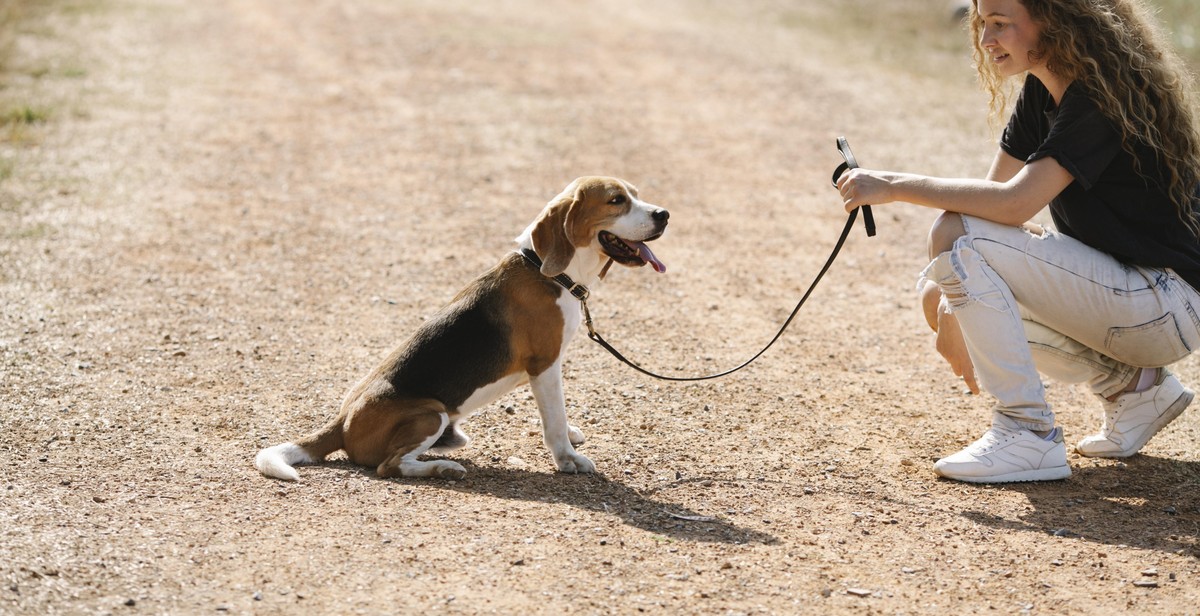How to Train Your Dog to Walk on a Leash: Loose-Leash Walking Techniques
Walking your dog on a leash is not only a great way to exercise your furry friend, but it’s also an important aspect of responsible pet ownership. However, many dogs pull on their leash, making the experience frustrating and even dangerous for both the owner and the dog. The good news is that with the right techniques, you can train your dog to walk on a leash without pulling.
The Importance of Loose-Leash Walking
Loose-leash walking is a technique that teaches your dog to walk calmly and comfortably on a leash without pulling. This type of walking is important for several reasons:
- It allows you to maintain control over your dog
- It prevents your dog from pulling you into dangerous situations
- It makes the walking experience more enjoyable for both you and your dog
Training Techniques for Loose-Leash Walking
There are several techniques you can use to train your dog to walk on a leash without pulling:
- Positive reinforcement: Reward your dog for walking calmly on a loose leash.
- Stop-and-go: Stop walking when your dog pulls and resume walking when your dog relaxes the leash.
- Change direction: Turn and walk in the opposite direction when your dog pulls on the leash.
- Use a front clip harness: A front clip harness can help discourage pulling by redirecting your dog’s attention.
By using these techniques consistently and patiently, you can train your dog to walk on a leash without pulling and enjoy a safe and happy walking experience together.

Why is Loose-Leash Walking Important?
Loose-leash walking is an essential aspect of dog training. It involves teaching your dog to walk beside you on a leash without pulling or tugging, while keeping the leash relaxed. Loose-leash walking is important for the following reasons:
Safety
When a dog pulls on the leash, it can be dangerous for both the dog and the owner. A dog that pulls can easily slip out of their collar or harness and run into traffic, causing a potentially fatal accident. Loose-leash walking ensures that your dog stays close to you and reduces the risk of injury or harm.
Socialization
Loose-leash walking is an important part of socialization. When your dog pulls on the leash, it can be intimidating for other dogs and their owners. Loose-leash walking helps your dog to learn appropriate behavior around other dogs and people. This helps to build your dog’s confidence and makes them a joy to be around.
Exercise
Walking your dog is an important part of their exercise routine. However, if your dog is constantly pulling on the leash, it can be difficult to get the exercise they need. Loose-leash walking allows your dog to walk at a steady pace and get the exercise they need without leaving you exhausted.
Overall, loose-leash walking is an essential part of dog training. It helps to keep your dog safe, improves their socialization skills, and ensures that they get the exercise they need. With patience and consistency, you can train your dog to walk on a leash without pulling or tugging.

Common Problems with Leash Walking
Leash walking is an essential skill for any dog owner, but it can be challenging to train your dog to walk calmly on a leash. Here are some common problems that dog owners face when leash walking:
Pulling
Pulling is one of the most common problems that dog owners face when leash walking. Dogs naturally want to explore their surroundings, and when they see something interesting, they may pull on the leash to get to it. This can be frustrating for owners and can also be dangerous if the dog pulls too hard and escapes from their leash.
To prevent pulling, it’s essential to teach your dog to walk beside you on a loose leash. One effective technique is to stop walking as soon as your dog starts to pull. Stand still and wait for your dog to come back to you. Once they do, reward them with a treat and start walking again. Repeat this process every time your dog pulls, and they will soon learn that pulling won’t get them anywhere.
Chewing on the Leash
Some dogs have a tendency to chew on their leash when they’re leash walking. This can be frustrating for owners, and it can also be dangerous if the dog chews through the leash and escapes.
To prevent chewing, make sure that your dog has plenty of toys and chews to keep them occupied. You can also try spraying the leash with a bitter-tasting spray to discourage chewing. If your dog continues to chew on the leash, consider using a chain leash or a nylon leash with a metal core.
Leash Reactivity
Leash reactivity is when a dog becomes aggressive or fearful when they’re on a leash. This can be a challenging problem to tackle, and it’s essential to address it as soon as possible to prevent it from escalating.
To prevent leash reactivity, it’s important to socialize your dog from a young age and expose them to different people, animals, and environments. If your dog is already leash reactive, consider working with a professional dog trainer to address the issue.
- Pulling is a common problem when leash walking.
- Dogs may chew on their leash, which can be frustrating and dangerous.
- Leash reactivity can be a challenging problem to address.

Loose-Leash Walking Techniques
Once your dog is comfortable wearing a leash and collar, it’s time to start teaching them how to walk on a leash without pulling. Loose-leash walking is a crucial skill for any dog that goes on walks with their owners. Here are some techniques to help you achieve loose-leash walking:
Start Indoors
Start training your dog to walk on a leash indoors, where there are fewer distractions. Begin by attaching the leash to your dog’s collar and letting them drag it around the house. This will help your dog get used to the feeling of the leash and collar without any pressure.
Use a Short Leash
When you’re ready to start training your dog to walk on a leash, use a short leash. A shorter leash gives you more control over your dog’s movements and helps prevent them from pulling. A leash that is four to six feet in length is ideal for training purposes.
Positive Reinforcement
Positive reinforcement is a powerful tool for training your dog to walk on a leash. Reward your dog with treats, praise, or a favorite toy when they walk calmly by your side. This positive reinforcement will encourage your dog to repeat the behavior.
Stop and Go
If your dog starts to pull on the leash, stop walking and wait for them to come back to you. When your dog returns to your side, reward them with a treat or praise. This technique teaches your dog that pulling on the leash doesn’t get them where they want to go.
Turn and Change Direction
Another technique to discourage pulling is to turn and change direction when your dog starts to pull. This will teach your dog to pay attention to you and follow your lead. Reward your dog when they follow you in the new direction.
Practice, Practice, Practice
Training your dog to walk on a leash takes time and practice. Start with short training sessions and gradually increase the length of your walks. Be patient and consistent, and remember to reward your dog for good behavior. With time and practice, your dog will learn to walk calmly by your side on a loose leash.
By using these loose-leash walking techniques, you can train your dog to walk calmly by your side on a leash without pulling. Remember to be patient, consistent, and use positive reinforcement to encourage good behavior. With practice, your dog will be a pro at loose-leash walking in no time!

Conclusion
Training your dog to walk on a leash is an essential part of responsible pet ownership. With patience, consistency, and positive reinforcement, you can teach your furry friend to walk calmly and comfortably by your side. Remember to start small and gradually increase the difficulty of the training sessions. Use treats and praise to reward good behavior and redirect your dog’s attention when necessary.
Loose-leash walking techniques are the most effective way to train your dog to walk on a leash. These techniques involve teaching your dog to walk on a loose leash rather than pulling or tugging on the leash. By using these techniques, you can ensure that your dog is comfortable and happy during walks and that you can enjoy a peaceful and relaxing stroll with your furry friend.
It’s important to remember that every dog is different and may require different training methods. If you’re struggling to train your dog to walk on a leash, don’t hesitate to seek professional help from a dog trainer or behaviorist.
- Be patient and consistent with your training
- Use positive reinforcement to reward good behavior
- Start small and gradually increase the difficulty of the training sessions
- Redirect your dog’s attention when necessary
- Loose-leash walking techniques are the most effective way to train your dog to walk on a leash
- If you’re struggling to train your dog, seek professional help from a dog trainer or behaviorist
| Training Techniques | Pros | Cons |
|---|---|---|
| Clicker training | Effective and precise | Requires a clicker and may take time to learn |
| Positive reinforcement | Encourages good behavior and strengthens the bond between you and your dog | May take time to see results and can be expensive if using treats |
| Leash corrections | Immediate feedback and can be effective for some dogs | Can be harmful if not done correctly and can damage the bond between you and your dog |
Remember, training your dog to walk on a leash is a journey, not a destination. With patience, consistency, and the right techniques, you can enjoy many happy and peaceful walks with your furry friend.
